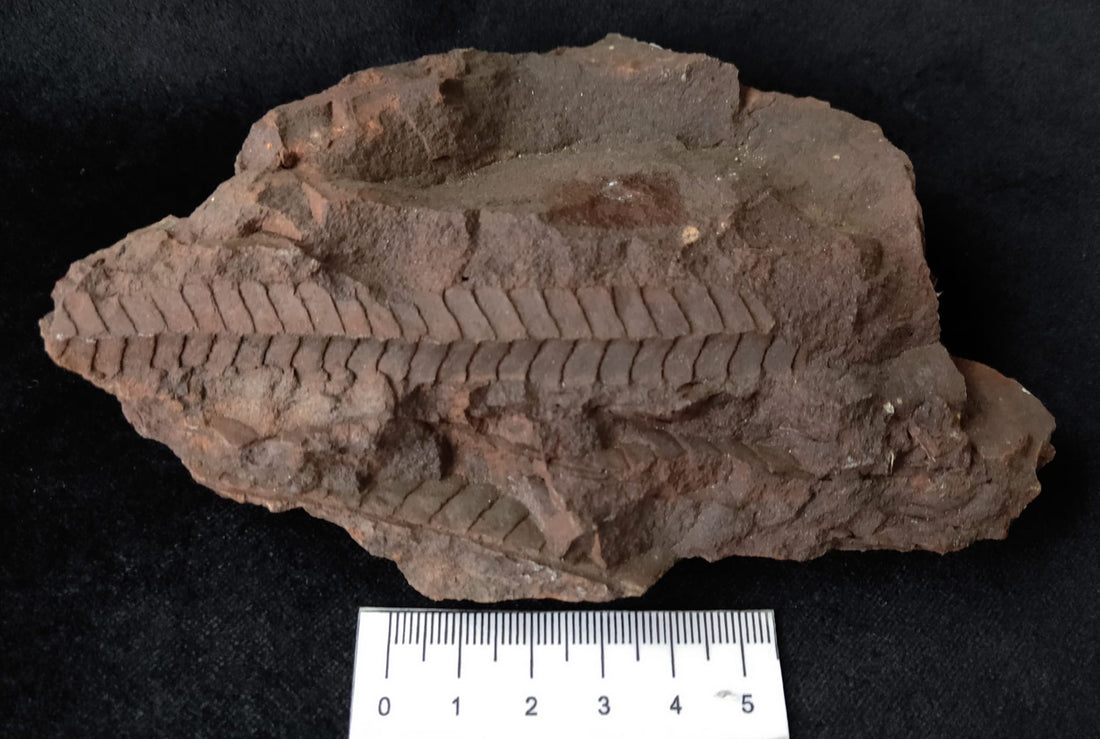
Otozamites Feistmantelli: A Glimpse into the Jurassic Flora of Queensland
Share
Otozamites feistmantelli is a fascinating fossil plant species that offers a window into the lush vegetation of the Jurassic period. Discovered in the Walloon Coal Measures of Durikai, Queensland, Australia, this species provides valuable insights into the paleoecology and geological history of the region.
Morphology and Identification
Otozamites feistmantelli belongs to the Bennettitales, an extinct order of seed plants that thrived during the Mesozoic era. The Mesozoic Era, often referred to as the “Age of Reptiles,” is a significant period in Earth’s geological history that lasted from about 252 to 66 million years ago, it is divided into three major periods: the Triassic, Jurassic, and Cretaceous. These plants are characterized by their pinnate leaves, which resemble those of modern cycads and ferns. The leaves of Otozamites feistmantelli are typically elongated and divided into numerous leaflets, giving them a feather-like appearance.
- Leaf Structure: The leaves are pinnate, with each leaflet attached to a central rachis. The leaflets are narrow, elongated, and have parallel venation, which is a key identifying feature.
- Size: Fossil specimens of Otozamites feistmantelli can vary in size, but they generally measure around 14 cm in length and 13 cm in width.
- Surface Texture: The leaf surface often shows fine details of the venation and cuticle, which are preserved in the fossil record.
Geological Context
The Walloon Coal Measures, where Otozamites feistmantelli is found, date back to the Jurassic period, approximately 180 million years ago. This geological formation is part of the Surat Basin, a significant intracratonic basin in eastern Australia known for its extensive deposits of coal and fossil plants. The Walloon Coal Measures were formed in a deltaic environment, characterized by the deposition of sediments by rivers in a coastal plain setting. This environment provided the ideal conditions for the preservation of plant material, as the fine-grained sediments effectively encapsulated and protected the delicate structures of the plant leaves.
The fossils within the Walloon Coal Measures are typically found in fine-grained sedimentary rocks, such as shales and siltstones. These rocks have preserved the intricate details of the plant leaves, including their venation and surface textures, allowing paleobotanists to study and understand the ancient flora of the region. The exceptional preservation of these fossils offers valuable insights into the paleoecology and geological history of the Jurassic period in Queensland
Scientific Importance
Otozamites feistmantelli, along with other plant fossils from the Walloon Coal Measures, indicate that the region was once covered by dense forests, dominated by gymnosperms and ferns.The presence of Otozamites feistmantelli suggests a warm and humid climate, which supported the growth of lush vegetation The diversity of plant fossils in the Walloon Coal Measures highlights the rich biodiversity of the Jurassic flora in this region.
Otozamites feistmantelli is a remarkable fossil plant, its well-preserved leaves provide valuable information about the morphology, ecology, and geological history of the region. The study of such plant fossils is crucial for several reasons. These fossils provide paleobotanists with invaluable information that helps reconstruct ancient ecosystems and understand the Earth’s geological history.
Here are some key points highlighting the importance of studying plant fossils such as Otozamites feistmantelli:
-
Reconstructing Ancient Ecosystems: Plant fossils offer a glimpse into the composition and structure of ancient vegetation. By examining these fossils, scientists can infer the types of plants that existed, their interactions, and the overall biodiversity of past ecosystems. This helps in creating detailed reconstructions of ancient landscapes and understanding how they functioned.
-
Tracking Climate Changes: Plant fossils are excellent indicators of past climatic conditions. Different plants thrive in specific climates, so the presence of certain plant species in the fossil record can reveal information about the temperature, humidity, and atmospheric composition of ancient environments. This helps scientists track changes in climate over geological time and understand the factors driving these changes.
-
Understanding Evolution: Plant fossils provide evidence of the evolutionary history of plants. By studying these fossils, paleobotanists can trace the development of different plant groups, identify evolutionary trends, and understand how plants adapted to changing environments over millions of years. This contributes to our knowledge of plant evolution and the origins of modern plant diversity.
-
Paleoecology: Plant fossils help in understanding the ecological relationships between different species and their environments. This includes studying plant-animal interactions, such as herbivory and pollination, as well as the role of plants in ancient food webs. Such insights are essential for reconstructing the dynamics of past ecosystems.
-
Geological Correlation: Plant fossils can be used to correlate geological strata across different regions. Certain plant species are characteristic of specific geological periods, so their presence in rock layers can help date and correlate these layers. This is important for constructing accurate geological timelines and understanding the distribution of ancient environments.
-
Environmental Changes: Plant fossils provide evidence of how vegetation and ecosystems responded to major environmental changes, such as volcanic eruptions, asteroid impacts, and shifts in sea levels. This helps scientists understand the resilience and adaptability of ecosystems in the face of environmental stressors.
References:
- Wikipedia
- Geoscience Australia
- The Fossil Forum
- CSIRO